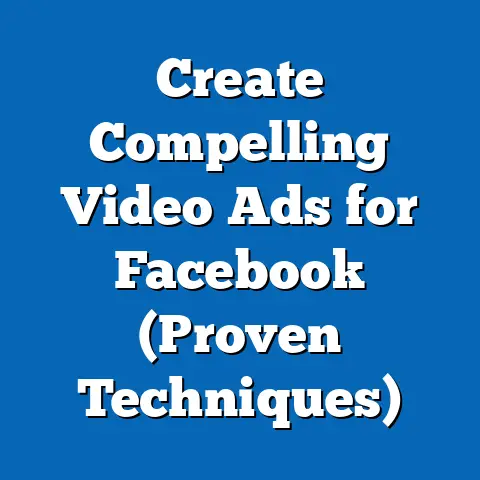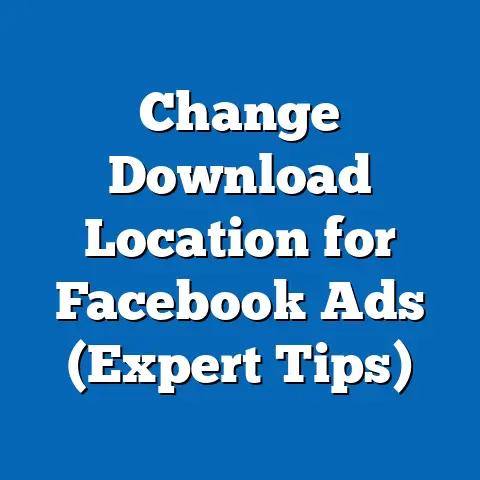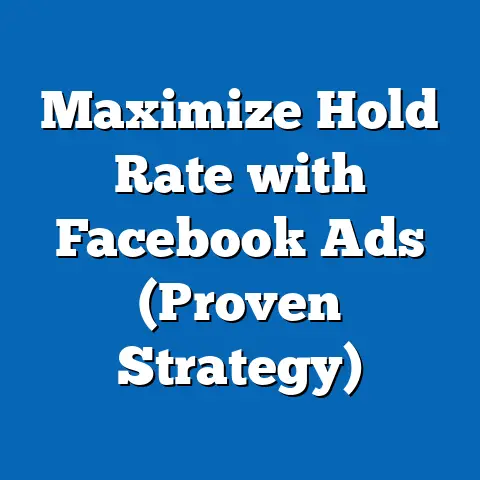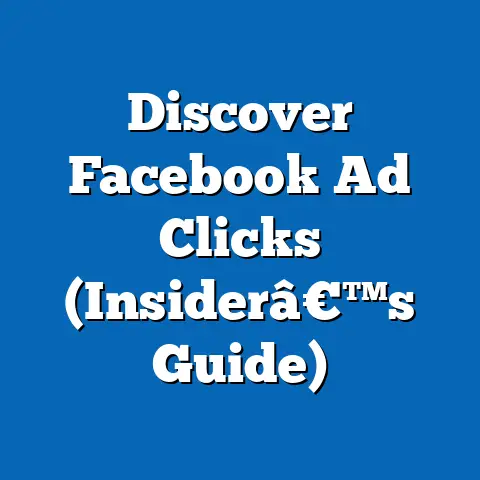Boost fb ad Team: Add Advertisers Seamlessly (Expert Guide)
Facebook advertising. It’s a beast, isn’t it? I remember when I first started, I felt like I was throwing money into a black hole, hoping something would stick. But over the years, I’ve learned that a well-oiled Facebook ad machine is a powerful thing – a true engine for growth. And a crucial part of that machine is the team behind it.
I’ve seen firsthand how bringing in fresh talent can completely revitalize a campaign. I once worked with a small e-commerce business that was struggling to break through. Their ads were stale, their targeting was off, and their results were… well, let’s just say they weren’t pretty. We brought in a new advertiser, someone with a fresh perspective and a knack for creative copywriting. Within a few weeks, we saw a dramatic increase in click-through rates and conversions. The brand went from barely surviving to thriving, all because of a strategic addition to the team.
Adding new advertisers isn’t just about filling a seat; it’s about injecting new energy, skills, and ideas into your advertising efforts. It’s about scaling your capabilities and achieving results you never thought possible. This guide is designed to equip you with the knowledge and strategies you need to seamlessly integrate new advertisers into your team, unlocking their potential and driving your campaigns to new heights. I’m going to walk you through everything from identifying the right talent to fostering a collaborative environment, so you can build a Facebook ad team that’s not just good, but exceptional.
Understanding the Current Landscape of Facebook Advertising
The Facebook advertising landscape is constantly evolving. What worked last year might be obsolete today. We’re talking about algorithm updates, privacy changes, new ad formats, and a relentless stream of emerging trends. Staying ahead requires constant learning, adaptation, and, crucially, collaboration.
According to Statista, Facebook’s ad revenue reached a staggering $116.6 billion in 2023. That’s a lot of competition for attention! This intense competition underscores the need for innovative and strategic advertising approaches. A single advertiser, no matter how skilled, can only do so much. Building a team allows you to distribute the workload, leverage diverse skill sets, and brainstorm creative solutions.
However, adding new members isn’t always smooth sailing. I’ve seen teams struggle with:
- Communication breakdowns: Misunderstandings and lack of transparency can lead to conflicting strategies and wasted effort.
- Inconsistent branding: New advertisers might not fully grasp the brand’s voice and identity, resulting in disjointed messaging.
- Conflicting priorities: Different team members might have different goals, leading to internal friction and diluted results.
- Lack of training: New hires might not be fully equipped to use the tools and platforms effectively.
These challenges can hinder growth and prevent you from realizing the full potential of your advertising team. Addressing them proactively is essential for building a cohesive and high-performing unit. Remember, a strong team is more than just the sum of its parts; it’s a synergistic force that amplifies your advertising impact.
Takeaway: The Facebook advertising landscape demands collaboration and adaptability. Identifying and addressing the challenges of integrating new advertisers is crucial for maximizing your team’s effectiveness and staying ahead of the competition.
Identifying the Right Advertisers for Your Team
Finding the right talent is paramount. It’s not just about finding someone who knows how to use Facebook Ads Manager; it’s about finding someone who aligns with your team’s values, understands your brand, and brings something unique to the table.
Here are key factors to consider:
- Expertise: What specific skills are you looking for? Do you need someone with experience in lead generation, e-commerce, or brand awareness? Are they proficient in specific ad formats like video ads or carousel ads?
- Experience: How much experience do they have with Facebook advertising? Have they managed large budgets? Have they worked in your industry before? While experience is valuable, don’t discount potential based on demonstrated skills and a strong portfolio.
- Cultural Fit: Do they align with your team’s values and work style? Are they collaborative and communicative? Can they adapt to your company’s culture? This is often overlooked, but it’s critical for long-term success.
- Analytical Skills: Can they analyze data and draw meaningful insights? Are they comfortable using metrics to optimize campaigns? A data-driven approach is essential for effective Facebook advertising.
- Creative Thinking: Can they come up with innovative ad concepts and engaging copy? Creativity is what makes your ads stand out in a crowded newsfeed.
Evaluating Potential Advertisers:
- Review their previous work: Ask for case studies or examples of campaigns they’ve managed. Look for evidence of strong results and a clear understanding of advertising principles. I always ask for specific examples of campaigns that failed and what they learned from those failures. It tells me more about their analytical skills and willingness to learn.
- Understand their advertising philosophy: Ask them about their approach to Facebook advertising. Do they prioritize targeting, creative, or bidding strategies? How do they stay up-to-date with the latest trends?
- Assess their adaptability: Facebook advertising is constantly changing. Ask them how they handle algorithm updates and new ad formats. Are they willing to learn new skills and adapt their strategies?
- Conduct a trial project: If possible, give them a small project to work on before making a full-time offer. This allows you to assess their skills and work style in a real-world setting.
Onboarding Process:
A robust onboarding process is crucial for aligning new advertisers with your team’s vision. This should include:
- Company culture and values: Clearly communicate your company’s mission, values, and culture.
- Brand guidelines: Provide detailed brand guidelines, including voice, tone, and visual identity.
- Team dynamics: Introduce them to the rest of the team and explain how everyone works together.
- Tools and platforms: Provide training on the tools and platforms they’ll be using, such as Facebook Ads Manager, Google Analytics, and project management software.
- Campaign goals and strategies: Clearly define the goals and strategies for their specific campaigns.
Takeaway: Identifying the right advertisers involves a combination of assessing their skills, evaluating their cultural fit, and providing a comprehensive onboarding process. A well-defined process ensures that new hires are aligned with your team’s vision and equipped to contribute effectively.
Seamless Integration Strategies
Integrating a new advertiser into your team requires a deliberate and thoughtful approach. It’s not enough to simply assign them tasks and expect them to thrive. You need to create an environment that fosters communication, collaboration, and shared understanding.
Here are some key strategies for seamless integration:
- Establish Clear Communication Channels: Implement tools and processes that facilitate open and transparent communication. This includes regular team meetings, instant messaging platforms, and project management software. I’ve found that daily stand-up meetings, even if they’re just 15 minutes long, can make a huge difference in keeping everyone on the same page.
- Set Clear Expectations: Clearly define roles, responsibilities, and performance metrics. Make sure everyone understands what’s expected of them and how their work contributes to the overall team goals. Use a RACI matrix (Responsible, Accountable, Consulted, Informed) to clarify roles and responsibilities for each task or project.
- Provide Ongoing Training and Support: Offer continuous learning opportunities to help new advertisers stay up-to-date with the latest trends and best practices. This can include online courses, industry conferences, and mentorship programs. I personally dedicate a few hours each week to learning about new Facebook ad features and strategies, and I encourage my team to do the same.
- Foster a Culture of Collaboration: Encourage team members to share ideas, provide feedback, and work together on projects. Create opportunities for informal interaction, such as team lunches or social events. I’ve found that a casual brainstorming session over coffee can often lead to breakthrough ideas.
- Implement a Mentorship Program: Pair new advertisers with experienced team members who can provide guidance and support. This allows them to learn from the expertise of others and build strong relationships within the team. A mentor can provide valuable insights into the company culture, team dynamics, and best practices.
- Encourage Feedback and Iteration: Create a safe space for team members to provide feedback on each other’s work. Encourage them to experiment with new strategies and learn from their mistakes. I always emphasize that failure is a learning opportunity, not a reason for blame.
Best Practices for Onboarding:
- Welcome Package: Create a welcome package that includes essential information about the company, team, and their role. This can include a company handbook, brand guidelines, and a list of important contacts.
- Initial Meeting: Schedule an initial meeting to introduce them to the team, explain their role, and answer any questions they may have.
- Training Sessions: Provide training sessions on the tools and platforms they’ll be using, such as Facebook Ads Manager, Google Analytics, and project management software.
- Shadowing Opportunities: Allow them to shadow experienced team members to observe their workflow and learn best practices.
- Regular Check-ins: Schedule regular check-ins to provide feedback, answer questions, and address any concerns.
Takeaway: Seamless integration requires a proactive approach that focuses on communication, collaboration, and ongoing support. By implementing these strategies, you can create an environment where new advertisers feel valued, supported, and empowered to contribute effectively.
Tools and Technologies for Collaboration
In today’s digital age, technology plays a crucial role in facilitating seamless collaboration within Facebook ad teams. The right tools can streamline workflows, enhance communication, and improve overall productivity.
Here are some essential tools and technologies for collaboration:
- Project Management Tools:
- Asana: A popular project management tool that allows you to create tasks, assign responsibilities, set deadlines, and track progress. It also integrates with other popular tools like Slack and Google Drive.
- Trello: A visual project management tool that uses boards, lists, and cards to organize tasks and projects. It’s particularly useful for teams that prefer a more visual approach.
- Monday.com: A versatile project management platform that offers a wide range of features, including task management, collaboration, and reporting. It’s suitable for teams of all sizes.
- Communication Platforms:
- Slack: A widely used messaging platform that allows you to create channels for different teams, projects, or topics. It also supports file sharing, voice calls, and video conferencing.
- Microsoft Teams: A collaboration platform that combines chat, video conferencing, file storage, and application integration. It’s particularly popular among organizations that already use Microsoft products.
- Google Workspace: A suite of online productivity tools that includes Gmail, Google Calendar, Google Drive, and Google Meet. It’s ideal for teams that rely heavily on Google’s ecosystem.
- Ad Management Software:
- Facebook Ads Manager: Facebook’s native ad management platform that allows you to create, manage, and optimize your Facebook ad campaigns. It offers a wide range of features, including targeting options, bidding strategies, and reporting tools.
- Hootsuite Ads: A social media management platform that allows you to manage your Facebook ads alongside your other social media campaigns. It offers features like ad scheduling, performance tracking, and reporting.
- AdEspresso: A Facebook ad management tool that simplifies the process of creating and optimizing ad campaigns. It offers features like A/B testing, automated bidding, and reporting.
- Design and Creative Tools:
- Canva: A user-friendly graphic design tool that allows you to create visually appealing ad creatives without requiring advanced design skills. It offers a wide range of templates, graphics, and fonts.
- Adobe Creative Cloud: A suite of professional design tools that includes Photoshop, Illustrator, and Premiere Pro. It’s ideal for teams that require advanced design capabilities.
- Loom: A video recording tool that allows you to quickly create and share screen recordings. It’s particularly useful for providing feedback on ad creatives or explaining complex concepts.
- Asana: A popular project management tool that allows you to create tasks, assign responsibilities, set deadlines, and track progress. It also integrates with other popular tools like Slack and Google Drive.
- Trello: A visual project management tool that uses boards, lists, and cards to organize tasks and projects. It’s particularly useful for teams that prefer a more visual approach.
- Monday.com: A versatile project management platform that offers a wide range of features, including task management, collaboration, and reporting. It’s suitable for teams of all sizes.
- Slack: A widely used messaging platform that allows you to create channels for different teams, projects, or topics. It also supports file sharing, voice calls, and video conferencing.
- Microsoft Teams: A collaboration platform that combines chat, video conferencing, file storage, and application integration. It’s particularly popular among organizations that already use Microsoft products.
- Google Workspace: A suite of online productivity tools that includes Gmail, Google Calendar, Google Drive, and Google Meet. It’s ideal for teams that rely heavily on Google’s ecosystem.
- Facebook Ads Manager: Facebook’s native ad management platform that allows you to create, manage, and optimize your Facebook ad campaigns. It offers a wide range of features, including targeting options, bidding strategies, and reporting tools.
- Hootsuite Ads: A social media management platform that allows you to manage your Facebook ads alongside your other social media campaigns. It offers features like ad scheduling, performance tracking, and reporting.
- AdEspresso: A Facebook ad management tool that simplifies the process of creating and optimizing ad campaigns. It offers features like A/B testing, automated bidding, and reporting.
- Canva: A user-friendly graphic design tool that allows you to create visually appealing ad creatives without requiring advanced design skills. It offers a wide range of templates, graphics, and fonts.
- Adobe Creative Cloud: A suite of professional design tools that includes Photoshop, Illustrator, and Premiere Pro. It’s ideal for teams that require advanced design capabilities.
- Loom: A video recording tool that allows you to quickly create and share screen recordings. It’s particularly useful for providing feedback on ad creatives or explaining complex concepts.
How These Tools Enable Real-Time Feedback:
- Project Management Tools: Allow team members to comment on tasks, provide updates, and track progress in real-time.
- Communication Platforms: Enable instant messaging and video conferencing for quick and efficient communication.
- Ad Management Software: Provides real-time performance tracking and reporting, allowing team members to make data-driven decisions.
- Design and Creative Tools: Facilitate collaborative design and feedback processes, allowing team members to iterate on ad creatives quickly.
Takeaway: Technology is a powerful enabler of collaboration within Facebook ad teams. By implementing the right tools and technologies, you can streamline workflows, enhance communication, and improve overall productivity.
Measuring Success and Iterating
Measuring the success of your integration efforts and the overall performance of your advertising team is essential for continuous improvement. You need to track key performance indicators (KPIs) and conduct regular check-ins to gather feedback and identify areas for improvement.
Here are some key KPIs to track:
- Campaign Performance: Track metrics like click-through rate (CTR), conversion rate, cost per acquisition (CPA), and return on ad spend (ROAS). These metrics provide insights into the effectiveness of your ad campaigns.
- Team Productivity: Measure the number of campaigns launched, ads created, and optimizations made by the team. This provides insights into the team’s overall productivity.
- Team Collaboration: Assess the level of collaboration within the team. This can be measured through surveys, feedback sessions, and observation.
- New Advertiser Performance: Track the performance of new advertisers to assess their integration and contribution to the team.
- Team Satisfaction: Measure team satisfaction through surveys and feedback sessions. A happy and motivated team is more likely to be productive and effective.
Conducting Regular Check-Ins and Performance Reviews:
- Weekly Team Meetings: Schedule weekly team meetings to discuss progress, challenges, and upcoming priorities.
- Monthly Performance Reviews: Conduct monthly performance reviews to assess individual and team performance. Provide feedback and identify areas for improvement.
- Quarterly Strategy Reviews: Conduct quarterly strategy reviews to evaluate the overall effectiveness of your advertising strategy and make adjustments as needed.
- Anonymous Feedback Surveys: Use anonymous feedback surveys to gather honest feedback from team members about their experiences and suggestions for improvement.
The Iterative Approach:
The key to success is to embrace an iterative approach. This means continuously refining your processes and strategies based on data and feedback.
- Experiment with New Strategies: Encourage team members to experiment with new strategies and ad formats.
- A/B Test Everything: A/B test different ad creatives, targeting options, and bidding strategies to identify what works best.
- Analyze Data Regularly: Analyze data regularly to identify trends and patterns.
- Adjust Your Strategy Based on Data: Adjust your strategy based on data and feedback.
- Document Your Findings: Document your findings and share them with the team.
Takeaway: Measuring success and embracing an iterative approach are crucial for continuous improvement. By tracking KPIs, conducting regular check-ins, and continuously refining your processes and strategies, you can optimize your Facebook ad campaigns and achieve remarkable results.
Conclusion
Adding new advertisers to your Facebook ad team is more than just a logistical task; it’s an opportunity to inject fresh perspectives, expand your skillset, and ultimately, drive better results. I’ve seen it happen time and time again – a strategic addition to the team can be the catalyst for explosive growth.
But success hinges on a thoughtful and deliberate approach. It’s about identifying the right talent, providing a seamless integration process, fostering a collaborative environment, and continuously measuring and iterating. It’s about building a team that’s not just competent, but truly exceptional.
Remember the e-commerce business I mentioned at the beginning? Their success wasn’t just about hiring a talented advertiser; it was about creating an environment where that advertiser could thrive, where their ideas were valued, and where they were empowered to make a difference.
So, embrace the journey of adding new advertisers to your team. It might seem daunting at first, but with the right strategies and tools, you can unlock their potential and achieve remarkable success in your Facebook advertising endeavors. Don’t be afraid to experiment, learn from your mistakes, and continuously strive for improvement. The rewards are well worth the effort.
Call to Action
Ready to take your Facebook advertising team to the next level? Start implementing the strategies discussed in this article today! I encourage you to share your experiences and successes in adding new advertisers to your teams. Let’s build a community of learning and growth within the Facebook advertising space. What are your biggest challenges in building your Facebook ad team? Share your thoughts in the comments below!






